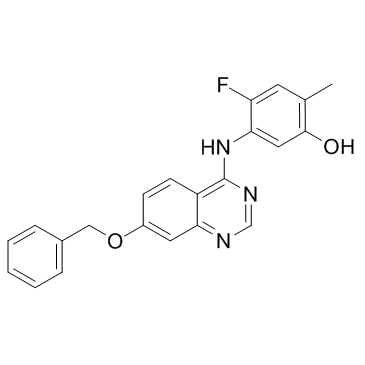| Description |
ZM323881 is a potent and selective VEGFR2 inhibitor with an IC50 of less than 2 nM.
|
| Related Catalog |
|
| Target |
VEGFR2:2 nM (IC50)
|
| In Vitro |
ZM323881 is an anilinoquinazoline that potently inhibits VEGFR2 (KDR) tyrosine kinase activity anddemonstrates excellent selectivity versus other receptor tyrosine kinases, including PDGFRβ, FGFR1, EGFR and erbB2 (IC50>50 μM). ZM323881 inhibits VEGF-A-induced endothelial cell proliferation(IC50=8 nM) and VEGFR2 tyrosine phosphorylation[1]. ZM323881 inhibits activation of VEGFR-2, but not of VEGFR-1, epidermal growth factor receptor (EGFR), platelet-derived growth factor receptor (PDGFR), or hepatocyte growth factor (HGF) receptor. In HAECs, ZM323881 completely inhibits VEGF-induced ERK phosphorylation at 1 μM[2].
|
| Kinase Assay |
Compounds (ZM323881) are incubated (20 minutes, room temperature) with enzyme in an N-2-hydroxyethylpiperazine-N'-2-ethanesulphonate (HEPES) (pH 7.5) buffered solution containing 10 mM MnCl2 and 2 μM ATP, in96-well plates coated with a poly(Glu, Ala, Tyr) 6:3:1 random copolymer substrate. Phosphorylated tyrosine is then detected bysequential incubation with mouse IgG anti-phosphotyrosine antibody a horseradish peroxidase(HRP)-linked sheep anti-mouse Ig antibody and 2,2'-azino-bis(3-ethylbenzthiazoline-6-sulphonic acid). IC50 data are interpolated by nonlin-ear regression[1].
|
| Cell Assay |
HUVEC cells isolated from umbilical cords are plated (at passage 2–8) in 96-wellplates (1000 cells/well) and dosed with ZM323881±VEGF-A (3 ng/mL), EGF (3 ng/mL), or basicfibroblast growth factor (bFGF, 0.3 ng/mL). The cultures are then incubated for 4 days. On day 4, the cultures are pulsed with 1 μCi/well of 3H-thymidine and reincubated for 4 hours. The cells are then harvested and assayed for the incorporation of tritium by using a beta-counter. IC50 data are interpolated[1].
|
| References |
[1]. Whittles CE, et al. ZM323881, a novel inhibitor of vascular endothelial growth factor-receptor-2 tyrosine kinase activity. Microcirculation. 2002 Dec;9(6):513-22. [2]. Endo A, et al. Selective inhibition of vascular endothelial growth factor receptor-2 (VEGFR-2) identifies a central role for VEGFR-2 in human aortic endothelial cell responses to VEGF. J Recept Signal Transduct Res. 2003;23(2-3):239-54.
|
